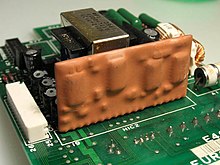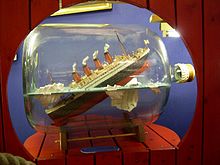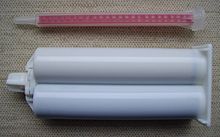Cast resin

A casting resin is a synthetic resin that is processed in liquid form into the end product and solidifies as this or its component. The still liquid resin is poured into a reusable or lost mold . This results in either pure cast resin bodies with freeform surfaces or other parts are included. Pouring is mostly used
- covering and protecting parts against the ingress of moisture, dust, foreign bodies, water, etc.
- electrical insulation, d. H. the increase in dielectric strength and protection against accidental contact.
- the fixation of parts with each other, the increase of the mechanical stability as well as the vibration and shock resistance.
In contrast to meltable casting compounds ( thermoplastics ), solidification takes place through a chemical cross-linking reaction and is irreversible ( thermoset ).
Applications
Typical uses of casting resins are:
- Potting and production of electrical components ( transformers , insulators , capacitors , semiconductors , assemblies)
- Potting of open contact points in cables and lines ( sleeves , underground cable branches , e.g. power and telephone lines), but here often also melting potting compounds
- Casts, e.g. B. Rapid prototyping and building and monument restoration
- Manufacture of the molds required for the casting by covering with casting resin and removing the original part after hardening
- Transparent potting, e.g. B. for aesthetic reasons, for permanent preservation or better manageability of fragile or perishable objects
- Cold glaze (scratch-resistant and weather-resistant surface protection, colorless or colored, glaze-like surfaces without a firing process for handicrafts)
- Model construction (replica of streams, rivers, lakes, etc.)
Components
Resin and hardener
These two components are mixed in a certain stoichiometric ratio to form a liquid mass and then react to form a solid. The crosslinking reaction is initiated or accelerated by heat, ultraviolet radiation or moisture. According to the chemical nature of the components, one differentiates z. B. between:
- Polyester resin
- Polyurethane resin ( polyurethane )
- Epoxy resin
- Silicone resin
- Vinyl ester resin
- Phenolic resin
- Acrylic resin ( PMMA )
Most resins and hardeners are unhardened and hazardous to health and the environment. Thus, special protective measures according to the safety data sheet must be observed.
Accelerators and additives
Depending on the exact chemical properties, catalysts can or must be added as accelerators in order to allow the crosslinking reaction to proceed more quickly. Plasticizers increase the elasticity of the casting resin, while additives such as defoamers , viscosity modifiers and adhesion promoters improve the final and processing properties. These components are either added separately by the user or are already contained in the resin and hardener.
Fillers and color
Fillers are fine-grained, mostly mineral substances such as quartz powder , sand , chalk , short glass or textile fibers , which increase mechanical strength and reduce shrinkage during hardening and the expansion coefficient of the finished molding material. In addition, these additives often make the casting resin cheaper, reduce the tendency to fire and usually also improve heat conduction. These advantages are paid for by the more difficult processing, since the viscosity of the resin increases and the filler can sediment . During industrial processing in casting systems , the filler usually leads to higher system wear.
Pigments ensure the desired coloring of the cast resin.
properties
Depending on the application, the following final properties usually characterize the cured casting resin:
- mechanical properties such as strength , elasticity , hardness , fracture toughness
- thermal or thermomechanical properties such as expansion coefficient , heat resistance , thermal conductivity , glass transition temperature
- electrical properties such as dielectric strength , insulation resistance , permittivity , tracking resistance
- other chemical-physical properties such as chemical resistance , fire behavior , adhesion , transparency in the case of clear resins
- Material price
In the case of casting resins, however, the properties in the liquid state during processing and curing are also important. In particular, these are:
- Viscosity: If the body or shape to be potted has small gaps and openings, perfect and bubble-free potting is only possible if the viscosity is sufficiently low.
- Reactivity: The reaction rate of the crosslinking reaction determines the pot life , i. H. the time during which the resin mixed with hardener can still be processed, i.e. is sufficiently low in viscosity. The curing time until the end of the crosslinking reaction also depends on it.
- Toxicity of raw materials and vapors during processing

A casting resin can be formulated with the optimum properties for the application and processing process through suitable selection and proportions of the components (recipe). Due to the large number of synthetic resins and fillers available, there is a very broad spectrum of different casting resins. It is therefore difficult to assign general characteristics. For example, highly filled epoxy resin is hard and brittle at room temperature, while on the other hand soft elastomers can be produced on the basis of silicone . Casting resins can also be used at high temperatures; with silicone resins, service temperatures of 180 ° C and, for a short time, up to 300 ° C are possible. All synthetic resins are electrical insulating materials, but using suitable fillers and processing methods, electrically conductive casting resins can also be produced. After curing, synthetic resins are often very resistant to environmental influences, but less so to organic liquids. They are only partially physiologically harmless. Recycling is only possible to a limited extent, the most economically and ecologically sensible use of cured cast resin waste is the utilization of the high heat of combustion when burning.
The viscosity is primarily determined by the filler content. Since a high degree of filling practically always results in better end properties, it is usually chosen so high that a sufficiently low flowability is just guaranteed. The reaction speed can be adjusted via the accelerator component. On the one hand, a high reactivity enables a short curing time and thus an efficient production and short mold occupation times. On the other hand, the required pot life and the curing process (see below) limit the reaction speed.
processing
Dosing, mixing and processing
The various components must first be dosed and mixed according to the recipe. The mixing ratio of the organic components resin, hardener and accelerator is usually specified by the manufacturer. Filler and color are either added by the user or, in the case of pre-filled systems, also mixed in by the manufacturer, so that only two components have to be mixed. One-component resins are premixed resin systems in which the curing reaction only begins above a starting temperature. Curing can be delayed for many months by storage below the starting temperature (refrigerated storage if necessary). Dosing and mixing are no longer necessary here.
The operations are carried out either manually or in industrial potting systems with different degrees of automation. Dynamic mixers such as stirred tanks and static mixers are used for mixing . Static mixers only mix the components through their flowing movement and have no moving parts themselves. Such static mixers are often disposable mixing tubes made of plastic and therefore do not need to be cleaned.
Mixing in the filler requires special care, since the liquid components have to wet the large surface of the fine-grained solid .
Often the casting resin mixture is heated in order to lower the viscosity. For optimal processing properties, the casting resin must be degassed , usually by vacuum , in order to remove disturbing air bubbles, dissolved gases and moisture.
Potting
The actual potting can also be done by machine or manually. The casting resin must not be poured into the mold too quickly, as this increases the risk of air inclusions. Ideally, the mold is filled from below so that the resin in the mold slowly rises and the air escapes through an opening at the top. The part to be potted or the mold must, if necessary, be brought to processing temperature before potting. In vacuum casting systems, the mold is filled with casting resin under vacuum (less than 10 mbar). If bubbles occur during potting, the residual pressure of the vacuum prevails in them. After potting, the mold is ventilated and atmospheric pressure compresses the bubbles. This results in practically bubble-free encapsulation, the filling of all spaces and thus particularly good electrical insulation properties, since partial discharges are avoided in this way. The casting compound and the casting must also be degassed and dried under vacuum beforehand.
Harden
The casting resin cures either independently (cold-curing resin) or by adding heat (thermosetting resin), sometimes also through ultraviolet radiation or moisture. The viscosity initially rises continuously until the gelation point is reached and the resin changes to the solid state. In the gelled, solid resin, the chemical reaction continues until the polymer network is completely formed and the final properties are achieved. As a result of the crosslinking reaction, the volume of the casting resin usually decreases. In the case of large-volume castings, this shrinkage must be compensated for by feeders such as in metal casting or by refilling, otherwise there is a risk of external indentations or cavities .
After gelling, the shrinkage can no longer be compensated for by flowing material. The result is internal stresses in the cast resin and, in the worst case, cracks . The stresses can be minimized by a curing process that is as uniform as possible and not too fast. To do this, reactivity and other influencing factors such as the supply of heat must be coordinated accordingly. This can e.g. B. done by curing cycles with several temperature levels of different duration.
In the automatic pressure gelling process (ADG), the casting resin in the mold is exposed to an overpressure of 2 to 5 bar during curing. As a result, material is continuously re-pressed to compensate for shrinkage. With this method, very short curing times of 5 to 15 minutes can be achieved; on the other hand, complex and expensive molds are necessary. It is therefore used in the industrial series production of electrical insulators, for example.
Furthermore, the reaction is usually exothermic . In the case of large, compact castings, this can lead to problems if the heat of reaction from the cast resin accumulations cannot be sufficiently dissipated and the temperature in the casting increases. This in turn increases the reaction rate and thus again the exothermicity. The crosslinking reaction must not proceed too quickly, depending on the size of the casting, in order to avoid excessive heat development and thus an uncontrolled acceleration of the hardening process.
Individual evidence
- ↑ a b c d e f R. Stierli: Epoxy casting and impregnating resins for the electrical industry . In: Wilbrand Woebcken (ed.): Duroplaste (= plastic manual. Volume 10). 2nd Edition. Hanser, Munich / Vienna 1988, ISBN 3-446-14418-8 , pp. 510-527.
- ↑ Günter Oertel (Ed.): Polyurethane (= plastic manual. Volume 7). 3. Edition. Hanser, Munich / Vienna 1993, ISBN 3-446-16263-1 , pp. 497-501.
- ↑ Erhard Hornbogen, Ewald Werner, Gunther Eggeler Werkstoffe . 10th edition. Springer Berlin / Heidelberg 2012, ISBN 978-3-642-22560-4 , p. 435.
- ↑ European patent EP1524253.
- ^ Karl-Heinz Decker: Waste recycling and disposal of curable molding compounds . In: Wilbrand Woebecken (ed.): Duroplaste (= plastic manual. Volume 10). 2nd Edition. Hanser, Munich / Vienna 1988, ISBN 3-446-14418-8 , pp. 153–157.
- ↑ Andreas Küchler: High voltage technology . 2nd Edition. Springer, Berlin / Heidelberg / New York 2004, ISBN 3-540-21411-9 , p. 278.
literature
- Wilbrand Woebcken (Ed.): Duroplaste (= plastic manual . Volume 10). 2nd Edition. Hanser, Munich / Vienna 1988, ISBN 3-446-14418-8
- Manfred Beyer: Epoxy resins in electrical engineering (= contact & study . Volume 109). Expert Verlag, 1983, ISBN 3-885-08792-8
- Klaus-Peter Lührs: Embedding in synthetic resin . Creartec, 2007
- Klaus-Peter Lührs: Do-it-yourself molds: From model to replica with liquid molding compounds . 6th edition, Creartec, 2010, ISBN 978-3-939-90309-3



